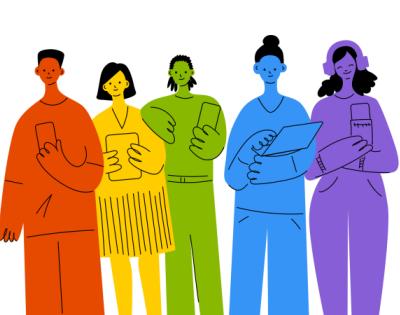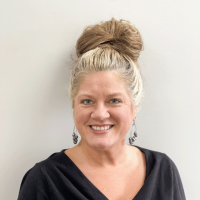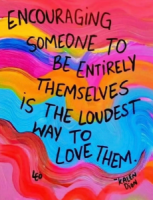
By Rachelle Haga, MSW, LMSW

Namaste! :-) My name is Rachelle and I'm an outpatient and in-home therapist with the Village's Grand Forks office. The Midwest has always been my home and I attended The University of North Dakota for both my undergraduate and graduate degrees in Social Work. I became a therapist because helping others to increase their definitions of happiness and quality of life is the most rewarding work I've known. My client-focused approach integrates solution-based therapy with acceptance and commitment therapy. I recognize my client as the expert on their goals and desired outcomes. Reaching out for support is brave! I'm honored to partner with individuals and families in their path toward goal attainment and increased wellbeing.
As a therapist serving LGBTQ+ individuals and their families, I am honored to work alongside and provide services to folks who identify as LGBTQ+. With my background in social work, I am compelled by my code of ethics to advocate for social justice for this special population. The LGBTQ+ community spans all ages, backgrounds, and walks of life. The odds are great that someone you serve professionally or someone you cherish personally is part of this colorful and often misunderstood umbrella.

As a new outpatient and in-home therapist with The Village, I was immediately heartened by the inclusive symbol on the public restroom in our reception area. It was one of the first signs that this is a place committed to providing a welcoming environment for all. When greeting new clients in my office, I introduce myself by stating my name and sharing my pronouns, she/her. This practice not only establishes my own identity but also invites clients to share their correct names and pronouns, or simply their names if they prefer. It’s a small step that acknowledges and respects individual identities, whether they use shortened names, different names, or specific pronouns. Each one of us can play a role in ensuring that our clients, regardless of gender identity or sexual orientation, are provided with safe, accepting, and supportive environments. Another way I like to advertise a safe space in my office is with a rainbow pillow and rug. Being an ally to underrepresented and marginalized people is something that is being done well at The Village, and I thank all my new colleagues for this, as I am grateful to be joining a team that actively supports and celebrates diversity.
While I’ve discussed the importance of LGBTQ+ acceptance, you might be wondering how this directly connects to LGBTQ+ mental health. Suicide is a critical public health issue, ranking as the second leading cause of death among young people. Alarmingly, LGBTQ+ youth face a significantly heightened risk. According to data from the CDC, LGBTQ+ youth are over four times more likely to attempt suicide compared to their peers. Additionally, a survey from The Trevor Project revealed that nearly half of LGBTQ youth seriously contemplated attempting suicide in the past year. However, LGBTQ+ young people who felt high social support from their family and/or community reported attempting suicide significantly less than those with lower social support. These stark statistics underscore the urgent need for acceptance and support to foster mental well-being within the LGBTQ+ community.
During my research, I came across a valuable list from the American Foundation for Suicide Prevention that outlines key strategies for reducing the risk of suicide. It was heartening to realize that my colleagues are already incorporating these principles into their practice.
Here are effective ways to help decrease the risk of suicide:
- Ensure Confidentiality and Show Genuine Care: Creating a safe, confidential space and demonstrating sincere concern can significantly support individuals at risk.
- Listen and Validate Experiences: Actively listening to their stories and validating their feelings without judgment helps them feel understood and respected.
- Avoid Minimizing or Giving Unsolicited Advice: It's crucial to avoid downplaying their experiences or offering unsolicited advice, as this can be dismissive and counterproductive.
- Ask Directly About Suicide: Don’t shy away from asking directly about suicidal thoughts. This openness can encourage them to share their struggles.
- Encourage Seeking Professional Support: Prompt them to consult with their primary care provider or other relevant mental health professionals to ensure they receive appropriate care and support.
At The Village, I am privileged to be part of a team of providers dedicated to serving LGBTQ+ clients with compassion and expertise. If you or someone you know is seeking support, you can reach us at 1-800-627-8220 to begin your journey with us.
In addition to our services, there are several invaluable resources available for LGBTQ+ individuals facing challenges:
- The Trevor Project: This organization offers 24/7 crisis intervention and suicide prevention services for LGBTQ+ youth through phone, text, and chat. Their support is vital in moments of need.
- Trans Lifeline: A peer support and crisis hotline run by and for trans people, available in the U.S. and Canada. It provides a critical lifeline for the trans community.
- LGBT National Help Center: They offer free and confidential peer-support and local resources through phone, text, and email hotlines for people of all ages within the LGBTQ+ community.
- National Suicide Prevention Lifeline: This service provides free and confidential support for people in distress, along with prevention and crisis resources tailored to everyone, including the LGBTQ+ community.